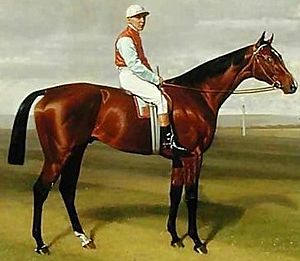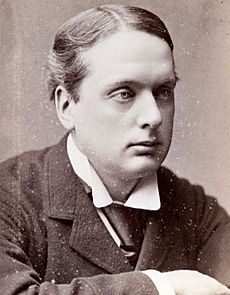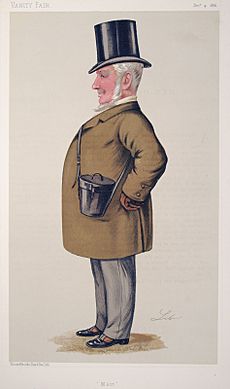Ladas (horse) facts for kids
Quick facts for kids Ladas |
|
|---|---|

"Ladas, winner of the 1894 Derby" painting by Emil Adam
|
|
| Sire | Hampton |
| Grandsire | Lord Clifden |
| Dam | Illuminata |
| Damsire | Rosicrucian |
| Sex | Stallion |
| Foaled | 1891 |
| Country | United Kingdom of Great Britain and Ireland |
| Colour | Bay |
| Breeder | Lord Rosebery |
| Owner | Lord Rosebery |
| Trainer | Mathew Dawson |
| Record | 11: 7-2-1 |
| Earnings | £18,558 |
| Major wins | |
| Woodcote Stakes (1893) Coventry Stakes (1893) Champagne Stakes (1893) Middle Park Plate (1893) 2000 Guineas (1894) Newmarket Stakes (1894) Epsom Derby (1894) |
|
Ladas (1891–1914) was a famous British Thoroughbred racehorse. He was also a successful sire, meaning he had many winning offspring. His racing career was very exciting because his owner, Lord Rosebery, became the Prime Minister of the United Kingdom during Ladas's biggest wins.
Ladas raced eleven times between 1893 and 1894, winning seven of those races. In 1893, he was the best two-year-old horse in Britain, winning all four of his races. These included important races like the Champagne Stakes and the Middle Park Stakes.
The next year, Ladas won the 2000 Guineas at Newmarket. He then won the Derby at Epsom. These two wins meant he had completed the first two parts of the special English Triple Crown. He tried to win the third part, the St Leger, but he was beaten.
After his racing career, Ladas became a stud horse. He produced many winners of important races. Ladas passed away in 1914.
Contents
About Ladas
Ladas was a beautiful bay horse, meaning he had a reddish-brown body and a black mane and tail. He stood almost 16 hands tall, which is about 1.6 meters. He was bred by his owner, Lord Rosebery, at the Crafton Stud in Buckinghamshire. Lord Rosebery was an important politician who became Prime Minister in 1894.
Ladas was trained by Mathew Dawson at Newmarket, Suffolk. Mathew Dawson was over 70 years old at the time. He had officially "retired" from training many horses in 1885. However, he still trained a few special horses, like Ladas, at his Melton House Stable. Ladas's main jockey, who rode him to his biggest wins, was Jack Watts.
Ladas's Parents
Ladas's father was a successful racehorse named Hampton. Hampton was known for winning long-distance races like the Goodwood Cup. He was also a "Champion sire" in 1887, meaning his offspring won a lot of races. Hampton also fathered two other Derby winners, Merry Hampton and Ayrshire.
Ladas's mother was a mare named Illuminata. She also produced other famous horses. These included a female horse named Gas, who was the mother of Derby winner Cicero. Illuminata also gave birth to Chelandry, who won the 1000 Guineas.
How Ladas Got His Name
The name Ladas came from a messenger of Alexander the Great. Lord Rosebery's father had used the name for a horse that ran in the 1869 Derby. That horse did not win, and Lord Rosebery, who was a student at Oxford University then, was very disappointed. He had told his friends to bet on the horse.
To make up for it, Lord Rosebery promised his friends something. He said if he ever had a horse with a "prime chance" to win the Derby, he would name it "Ladas." This way, his friends would know to bet on it. This promise is why he chose the name Ladas for this special colt. He had originally planned to name the horse "Hampton Wick."
Lord Rosebery and his trainer, Mathew Dawson, even disagreed on how to say the name. Rosebery said "Lar-dar," while Dawson insisted on "Lay-das."
Ladas's Racing Career

1893: Two-Year-Old Season
Before 1946, young racehorses in England could race without an official name. So, the horse who would become Ladas raced unnamed at first.
His first race was on May 31, 1893, in the Woodcote Stakes at the Epsom Derby meeting. He showed amazing speed and easily won. People quickly saw him as a very promising young horse.
Next, he went to Royal Ascot for the Coventry Stakes on June 13. He was the favourite to win. Ladas led the race from the start and pulled away from the other horses to win by one and a half lengths.
After a three-month break, "the Illuminata colt," as he was still called, returned in September. He raced in the Champagne Stakes at Doncaster. He easily beat his only rival, a horse named Sempronius.
After this win, he was officially named Ladas. He then went to Newmarket for the Middle Park Plate. This was the most important race for two-year-olds that season. Ladas was the clear favourite. He led halfway through the race and won easily by two lengths.
Ladas finished his first season unbeaten, winning all four of his races. He was the top choice to win the Derby the next year.
1894: Three-Year-Old Season
Winning the 2000 Guineas
Ladas grew stronger over the winter. His first race of 1894 was the 2000 Guineas on May 9. He was the favourite among eight horses. Ladas started near the back but moved up to third place. His jockey, Jack Watts, moved him forward to challenge for the lead. Ladas then pulled away to win by one and a half lengths.
Two weeks later, on May 23, Ladas raced in the Newmarket Stakes. He was a huge favourite against four other horses. He took the lead early and won easily by two lengths. After this win, his odds for the Derby became even shorter, meaning he was expected to win even more. Ladas became very famous, and police even guarded him to keep him safe.
The Epsom Derby Victory
The Epsom Derby took place on June 6. Ladas was the biggest favourite in the Derby's history, with very low odds. He started well, but his jockey held him back in fourth or fifth place. As the horses turned into the final straight, Ladas moved forward. He looked like he would win easily, but another horse, Matchbox, fought back. Ladas had to work hard for the first time in his career. He pushed ahead in the last part of the race and won by one and a half lengths.
The crowd cheered loudly for Ladas's victory. This win was very special for Lord Rosebery. As a student, he had made a three-part prediction for his life: he would marry a rich woman, become Prime Minister, and win the Derby. With Ladas's win, all three predictions came true! Police had to help Lord Rosebery get through the excited crowd. Even in the House of Commons, people cheered for Ladas's win. Lord Rosebery was proud of his horse. He even gave one of Ladas's winning horseshoes as a gift to the United States ambassador.
Races Against Isinglass
Ladas then raced against Isinglass, a horse who had won the Triple Crown in 1893. This big race was the £10,000 Princess of Wales's Stakes on July 5. Many important people watched, including the Prince of Wales. Ladas took the lead near the end, but Isinglass and another horse passed him. Ladas finished third. Some thought the slow start of the race might have affected the result.
Ladas met Isinglass again in the Eclipse Stakes on July 20. Isinglass was the favourite this time. Ladas started slowly, but his jockey moved him up to challenge Isinglass. The two Derby winners raced head-to-head. But Ladas could not catch Isinglass, who won by one length. Ladas's jockey admitted that Isinglass was simply the better horse that day.
The St Leger Race
Ladas went to Doncaster for the St Leger on September 12. This was his chance to win the Triple Crown. Ladas was the favourite. He started at the back of the group, as usual. He slowly moved closer to the front. He took the lead in the final part of the race. However, a female horse named Throstle challenged him. In the very last moments, Throstle pulled ahead and won by three-quarters of a length. The crowd's cheers for Ladas turned into cheers for the unexpected winner.
1895: Four-Year-Old Season
Ladas stayed in training for the 1895 season. Lord Rosebery wanted Ladas to have a special race against Isinglass, but Isinglass's owner said no.
Ladas had some training problems that kept him from racing much. He also became "short-tempered" and easily upset. He finally raced on September 27 in the £10,000 Jockey Club Stakes. Even though Ladas was not fully fit, he was still Lord Rosebery's top choice. He carried a lot of extra weight in the race. Ladas raced well at first but then tired. He finished fourth.
Despite this disappointing season, Lord Rosebery turned down a large offer of £20,000 for Ladas. He decided to retire Ladas to his own stud instead.
Ladas's Achievements
Mathew Dawson, Ladas's trainer, had trained many famous horses since the 1850s. He once said Ladas was the best horse he had ever trained. Later, he ranked Ladas second, just behind another great horse named St. Simon. Henry Chaplin, another famous horse owner, called Ladas the finest horse he had ever seen.
Ladas earned £5,768 as a two-year-old. He then earned an additional £12,790 in 1895.
Ladas's Life as a Sire
Ladas became a successful stud horse. He fathered several Classic winners, including Gorgos and Troutbeck. Another of his successful offspring was a gelding (a male horse that cannot breed) named Epsom Lad. Epsom Lad won the Eclipse Stakes and the Princess of Wales's Stakes in 1901. In total, Ladas's offspring won 196 races and earned over £97,000.
By 1912, Ladas was retired from breeding. He had become very bad-tempered. One writer said he had "worn himself out with his restlessness." Ladas passed away on March 31, 1914, at Lord Rosebery's stud farm at Mentmore.


